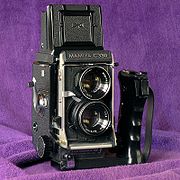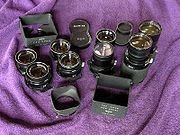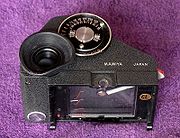
Mamiya C330
Encyclopedia

Twin-lens reflex camera
A twin-lens reflex camera is a type of camera with two objective lenses of the same focal length. One of the lenses is the photographic objective or "taking lens" , while the other is used for the viewfinder system, which is usually viewed from above at waist level...
introduced in the 1970s for the professional and advanced amateur photography markets. This model was 340 grams lighter than the previous model C33, which weighed 2040 grams (with 80 mm lens). The later C330f is an improvement on the C330 and was succeeded by the C330S with further improvements.
- Uses 120120 film120 is a film format for still photography introduced by Kodak for their Brownie No. 2 in 1901. It was originally intended for amateur photography but was later superseded in this role by 135 film...
and 220 rollfilms - With the rack and pinion bellows type focusing system, close-up photography is possible without attachments.
- Has a self-cocking one action 360° winding crank with a double exposureDouble ExposureDouble exposure is a photographic technique in which two images are captured and combined into a single image.Double exposure may also refer to:* Double patterning, a technique for improving the resolution of patterning semiconductors...
prevention device. Double exposure is also possible. The straight filmroll path has no right-angle turn and guarantees an absolutely flat film. - The backplate is changeable for single-exposure photography
- Dimensions: 122 (w) × 168 (h) × 114 (d)
- Weight: 1.7 kg (with standard lens)
The Mamiya C-series cameras are one of the two medium-format twin-lens reflex camera
Reflex camera
Reflex camera may refer to:*Single-lens reflex camera**Digital single-lens reflex cameras*Twin-lens reflex camera...
s in the world with interchangeable lenses, next to the Koni-Omegaflex.
Lenses

2 wide-angle lens
Wide-angle lens
From a design perspective, a wide angle lens is one that projects a substantially larger image circle than would be typical for a standard design lens of the same focal length; this enables either large tilt & shift movements with a view camera, or lenses with wide fields of view.More informally,...
es: 55 mm and 65 mm
2 normal lens
Normal lens
In photography and cinematography a normal lens, also called a standard lens, is a lens that reproduces perspective that generally looks "natural" to a human observer under normal viewing conditions, as compared with lenses with longer or shorter focal lengths which produce an expanded or...
es: 80 mm and 105 mm
3 telephoto lens
Telephoto lens
In photography and cinematography, a telephoto lens is a specific type of a long-focus lens in which the physical length of the lens is shorter than the focal length. This is achieved by incorporating a special lens group known as a telephoto group that extends the light path to create a long-focus...
es: 135 mm , 180 mm , and 250 mm
Every lens has its own Seikosha (chrome) or Seiko (black) leaf shutter system with a shutter speed
Shutter speed
In photography, shutter speed is a common term used to discuss exposure time, the effective length of time a camera's shutter is open....
of B, 1' -1/500 sec, X or M flash synchronisation and bulb mode.
The C330 camera has two shutter release buttons, an automatic conversion film counter 120/220, an indicator of the film in use, a removable back cover, a hexagonal distance scale rod for the different lenses, automatic parallax
Parallax
Parallax is a displacement or difference in the apparent position of an object viewed along two different lines of sight, and is measured by the angle or semi-angle of inclination between those two lines. The term is derived from the Greek παράλλαξις , meaning "alteration"...
compensation, an automatic exposure factor indicator and interchangeable focusing screens.
Accessories

- 7 interchangeable screens for focusing (matte, split image 4°, split image 6°, microprism, microprism + split image 45°, cross-hair and checkerboardCheckerboardA checkerboard or chequerboard is a board of chequered pattern on which English draughts is played. It is an 8×8 board and the 64 squares are of alternating dark and light color, often red and black....
pattern. - 3 types of finders: a prismfinderPorro prismIn optics, a Porro prism, named for its inventor Ignazio Porro, is a type of reflection prism used in optical instruments to alter the orientation of an image....
, a porrofinderPorro prismIn optics, a Porro prism, named for its inventor Ignazio Porro, is a type of reflection prism used in optical instruments to alter the orientation of an image....
and a CdSCadmium sulfideCadmium sulfide is the inorganic compound with the formula CdS. Cadmium sulfide is a yellow solid. It occurs in nature with two different crystal structures as the rare minerals greenockite and hawleyite, but is more prevalent as an impurity substituent in the similarly structured zinc ores...
-porrofinder (with a built-in CdS exposure meterPhotoresistorA photoresistor or light dependent resistor is a resistor whose resistance decreases with increasing incident light intensity. It can also be referred to as a photoconductor or CdS device, from "cadmium sulfide," which is the material from which the device is made and that actually exhibits the...
). - Three types of magnifying hoods: normal focusing hood, CdS magnifying hood and a magnifying hood 3.5× or 6×.
- Two paramenders for parallaxParallaxParallax is a displacement or difference in the apparent position of an object viewed along two different lines of sight, and is measured by the angle or semi-angle of inclination between those two lines. The term is derived from the Greek παράλλαξις , meaning "alteration"...
correction - gripholders and pistol grip
- backplates for sheet filmSheet filmSheet film is large format and medium format photographic film supplied on individual sheets of acetate or polyester film base rather than rolls. Sheet film was initially supplied as an alternative to glass plates...
External links
- Mamiya TLR System Summary by Graham Patterson (covers all Mamiya c-series cameras)

